
Patrick Victor Martindale White was an Australian writer who published 12 novels, three short-story collections, and eight plays, from 1935 to 1987.

Peter Handke is a novelist, playwright, translator, poet, film director, and screenwriter from Austria. Handke was awarded the Nobel Prize in Literature in 2019 "for an influential work that with linguistic ingenuity has explored the periphery and the specificity of human experience." The decision to award Handke a Nobel Prize was denounced internationally by a variety of public and academic intellectuals, writers, and journalists, who cited his support of the late Slobodan Milošević and Bosnian genocide denial.

Chloe Anthony Wofford Morrison, known as Toni Morrison, was an American novelist, essayist, book editor, and college professor. Her first novel, The Bluest Eye, was published in 1970. The critically acclaimed Song of Solomon (1977) brought her national attention and won the National Book Critics Circle Award. In 1988, Morrison won the Pulitzer Prize for Beloved (1987); she gained worldwide recognition when she was awarded the Nobel Prize in Literature in 1993.

John Maxwell Coetzee is a South African-born novelist, essayist, linguist, translator and recipient of the 2003 Nobel Prize in Literature. He is one of the most critically acclaimed and decorated authors in the English language. He has won the Booker Prize (twice), the CNA Prize (thrice), the Jerusalem Prize, the Prix Femina étranger, and The Irish Times International Fiction Prize, and holds a number of other awards and honorary doctorates.
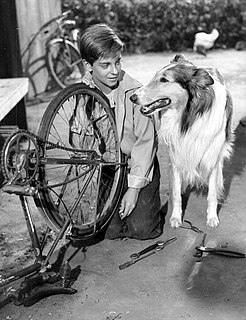
Lassie is a fictional female Rough Collie dog, and is featured in a short story by Eric Knight that was later expanded to a full-length novel called Lassie Come-Home. Knight's portrayal of Lassie bears some features in common with another fictional female collie of the same name, featured in the British writer Elizabeth Gaskell's 1859 short story "The Half Brothers". In "The Half Brothers", Lassie is loved only by her young master and guides the adults back to where two boys are lost in a snowstorm.
The Miles Franklin Literary Award is an annual literary prize awarded to "a novel which is of the highest literary merit and presents Australian life in any of its phases". The award was set up according to the will of Miles Franklin (1879–1954), who is best known for writing the Australian classic My Brilliant Career (1901). She bequeathed her estate to fund this award. As of 2016, the award is valued A$60,000.

The Twyborn Affair is a novel by Australian Nobel laureate Patrick White, first published in 1979. The three parts of the novel are set in a villa on the French Riviera before the First World War, a sheep station on the edge of Australia's Snowy Mountains in the inter-war period, and in London in the lead-up to the Second World War. White charts the transmigration of a soul through three different identities — Eudoxia, Eddie, and Eadith — two of them in female guise.
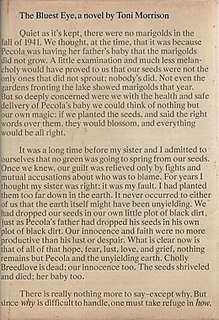
The Bluest Eye, published in 1970, is the first novel written by Toni Morrison. The novel takes place in Lorain, Ohio, and tells the story of a young African-American girl named Pecola who grew up following the Great Depression. Set in 1941, the story tells that she is consistently regarded as "ugly" due to her mannerisms and dark skin. As a result, she develops an inferiority complex, which fuels her desire for the blue eyes she equates with "whiteness".

George Elwood Smith is an American scientist, applied physicist, and co-inventor of the charge-coupled device (CCD). He was awarded a one-quarter share in the 2009 Nobel Prize in Physics for "the invention of an imaging semiconductor circuit—the CCD sensor, which has become an electronic eye in almost all areas of photography".
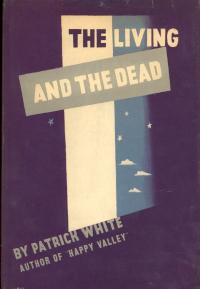
The Living and the Dead is a novel by Australian Nobel Prize laureate Patrick White, his second published book (1941). It was written in the early stages of World War II whilst the author alternated between the United Kingdom and the United States.

Jean Patrick Modiano, generally known as Patrick Modiano, is a French novelist and recipient of the 2014 Nobel Prize in Literature. He previously won the 2012 Austrian State Prize for European Literature, the 2010 Prix mondial Cino Del Duca from the Institut de France for lifetime achievement, the 1978 Prix Goncourt for Rue des boutiques obscures, and the 1972 Grand Prix du roman de l'Académie française for Les Boulevards de ceinture. His works have been translated into more than 30 languages and have been celebrated in and around France, but most of his novels had not been translated into English before he was awarded the Nobel Prize.
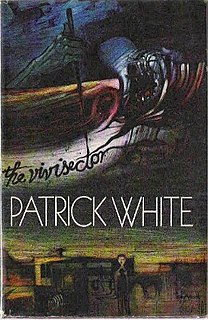
The Vivisector is the eighth published novel by Patrick White. First published in 1970, it details the lifelong creative journey of fictional artist/painter Hurtle Duffield. Named for its sometimes cruel analysis of Duffield and the major figures in his life, the book explores universal themes like the suffering of the artist, the need for truth and the meaning of existence.
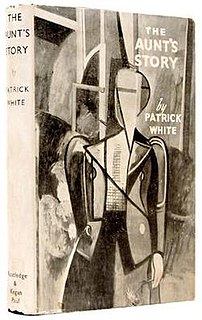
The Aunt's Story is the third published novel by the Australian novelist and 1973 Nobel Prize-winner, Patrick White. It tells the story of Theodora Goodman, a lonely middle-aged woman who travels to France after the death of her mother, and then to America, where she experiences what is either a gradual mental breakdown or an epiphanic revelation.
The sun was still a manageable ball above the ringing hills as Lou went outside. She walked through this stiff landscape, carrying her cold and awkward hands. She thought about the cardboard aunt, Aunt Theodora Goodman, who was both a kindness and a darkness. Lou touched the sundial, on which the time had remained frozen. She was afraid, and sad, because there was some great intolerable pressure from which it is not possible to escape. Lou looked back over her shoulder, and ran.
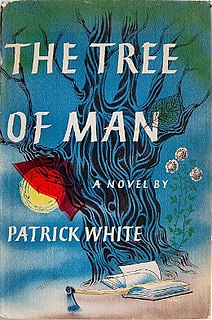
The Tree of Man is the fourth published novel by the Australian novelist and 1973 Nobel Prize-winner, Patrick White. It is a domestic drama chronicling the lives of the Parker family and their changing fortunes over many decades. It is steeped in Australian folklore and cultural myth, and is recognised as the author's attempt to infuse the idiosyncratic way of life in the remote Australian bush with some sense of the cultural traditions and ideologies that the epic history of Western civilisation has bequeathed to Australian society in general. "When we came to live [in Castle Hill, Sydney]", White wrote, in an attempt to explain the novel, "I felt the life was, on the surface, so dreary, ugly, monotonous, there must be a poetry hidden in it to give it a purpose, and so I set out to discover that secret core, and The Tree of Man emerged.". The title comes from A. E. Housman's poetry cycle A Shropshire Lad, lines of which are quoted in the text.
The man returned to his chair on the edge of the room, and looked at the blank book, and tried to think what he would write in it. The blank pages were in themselves simple and complete. But there must be some simple words, within his reach, with which to throw further light. He would have liked to write some poem or prayer in the empty book, and for some time did consider that idea, remembering the plays of Shakespeare that he had read lying on his stomach as a boy, but any words that came to him were the stiff words of a half-forgotten literature that had no relationship with himself.

The Solid Mandala, the seventh published novel by Australian author Patrick White, Nobel Prize winner of 1973, first published in 1966. It details the story of two brothers, Waldo and Arthur Brown, with a focus on the facets of their symbiotic relationship. It is set in White's fictional suburb of Sarsaparilla, a setting he often employed in his other books, such as with Riders in the Chariot. The book is typical of White's writing style, and is slow-paced, with little considerable action, instead focusing upon the inner turmoils of the aforementioned characters.
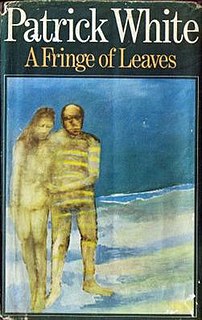
A Fringe of Leaves is the tenth published novel by the Australian novelist and 1973 Nobel Prize-winner, Patrick White.

The Nobel Prize in Literature is a Swedish literature prize that is awarded annually, since 1901, to an author from any country who has, in the words of the will of Swedish industrialist Alfred Nobel, "in the field of literature, produced the most outstanding work in an idealistic direction". Though individual works are sometimes cited as being particularly noteworthy, the award is based on an author's body of work as a whole. The Swedish Academy decides who, if anyone, will receive the prize. The academy announces the name of the laureate in early October. It is one of the five Nobel Prizes established by the will of Alfred Nobel in 1895. On some occasions the award has been postponed to the following year, most recently in 2018.
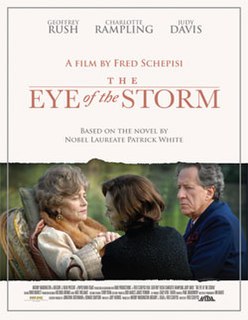
The Eye of the Storm is an Australian drama film directed by Fred Schepisi. It is an adaptation of Patrick White's 1973 novel of the same name. It stars Geoffrey Rush, Charlotte Rampling and Judy Davis. It won the critics award for best Australian feature at the 2011 Melbourne International Film Festival and had a September 2011 theatrical release.

Highbury is a heritage-listed residence located at 20 Martin Road in the inner eastern Sydney suburb of Centennial Park in the City of Sydney local government area of New South Wales, Australia. It was designed by William Nixon and built from 1912 to 1913. Highbury was the home of Australian novelist Patrick White for approximately twenty-six years, until his death in 1990. It is also known as the Patrick White House; Patrick White's House. The property is privately owned. It was added to the New South Wales State Heritage Register on 19 November 2004.
This article presents a list of the historical events and publications of Australian literature during 1973.


















